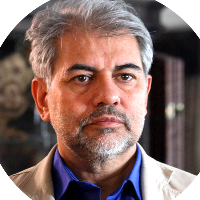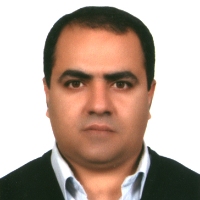Investigation and analysis of the virtual cross of St. Stepanos Julfa Church in Tabriz(From the perspective of Gerard Genet's intertext types)
From the very beginning, Christianity, as the divine religion, opposed the mysterious and blasphemous mirrors of its age based on bloodshed and pleasure, demanding the return of all to the one God. The resurrection and return to divine justice finally brought death to Christ on the cross. Christ welcomed it and, by sacrificing his body, caused the sins of the human race to be forgiven from the beginning. By the resurrection, he hoped the path of forgiveness continues. He revived the heart of his nation. Most of Christ's audience was illiterate, and on the other hand, the religion of Christ faced many difficulties and oppositions from the beginning. Many of these motifs have been used on church wall surfaces to sanctify places and teach religious teachings to believers. The Church of the Holy Stephen is located in the Aras Free Zone, 6 km from the village of Darreh Sham, 15 km west of the city of Julfa, in a place called Ghezel Vanak (Red Monastery) in East Azerbaijan Province. The church was built on the banks of the Aras River on a hillside called Maghard, which is why it is mentioned in Armenian written sources as "Deir Maghard". St. Stephen is one of the seven pious people who were ordained by the apostles of Jesus Christ and became missionaries of Christianity. Stephen is mentioned as the first martyr of Christianity in the Old Testament. The Jews of Jerusalem accused him of speaking against the Jewish law, arresting and stoning Stephen. In Christian symbolism, the church building has different meanings. Its original meaning is the house of God, but in some cases it has been compared to the lifeless body of Christ on the cross. The sacred building is primarily the image of Christ as the essence of divinity manifested in this soil, and in fact the plan of the cathedral is like the image of Christ crucified. Symbolic images served as a way to hide and spread Christian holiness. St. Stephen's Church in Julfa, Tabriz, is one of the buildings whose maximum external and internal surfaces are decorated and sanctified with various decorations. The exterior and interior surfaces of this beautiful and magnificent building are covered and decorated with various reliefs, paintings and sculptures. The interior walls are decorated with plaster painting techniques, and the exterior and exterior walls of the church are decorated with a variety of reliefs and small sculptures. Exterior wall motifs and decorations include written inscriptions, small sculptures of sacred animals and birds, various crosses, abstract inscriptions, and human motifs. The face of Christ is explicitly and symbolically depicted in four main directions on the outer walls in human reliefs and is painted several times inside the main church, but the face of Stephen is explicitly depicted in only one inscription, in which the last moments of Stephen's life are the time of the stone. His starling is depicted. The abundance of reliefs and beautiful decorations of this building engages the mind of the viewer and keeps the main inscriptions of two colors, however, with a careful examination, five inscriptions can be separated from the other reliefs. These inscriptions are approximately equal in height on the walls on all four sides of the church in four main directions. These inscriptions are very similar in terms of form and content, and their virtual arrangement correctly and in line with each other evokes a single meaning and formally resembles a cross hidden from the minds and eyes of viewers. Among many decorations, several inscriptions similar to the church's icons, with a specific composition and distance, are placed on the church's outer walls in four main directions. By virtually connecting these inscriptions, a unique and meaningful form is formed, forming a cross in form and having a lot of semantic connection and entanglement in terms of content. The horizontal axis of the virtual cross consists of two inscriptions. The first inscription is symbolically drawn at the end of the southern part of the horizontal axis of the cross with the theme of the election of Christ as the chosen one and sitting on the throne. The second inscription is drawn at the northern end of the horizontal axis of the cross with the theme of Christ's resurrection. The vertical axis of the virtual cross consists of three inscriptions, two of which are the testimony of the enemies, the crucifixion of Christ and the stoning of St. Stephen, and the other one is the salvation of Christ. These inscriptions were created under the influence of common sacred icons in the church.
These few inscriptions are secretly installed among the wall decorations of the church, specifically in connection with each other and with a predetermined intention. This cryptography and secrecy of the cross through inscriptions among the multitude of reliefs necessitates this research to analyze and study its form and content and is the main issue of the present study. Accordingly, first, the meanings of the symbols in the inscriptions were analyzed, then the analysis of these inscriptions is based on intertextual views from Gerard Genet's point of view in order to read the relationships between the inscriptions in terms of form and content relationship to confirm the form of the virtual cross. Any relationship that is formed based on co-presence between two or more texts is called intertextuality. Intertextuality is formed when two texts have a single element or elements. The presence of one element of a text in another text or the presence of several elements of one text in another text or the presence of several elements of several texts in a specific text is the main type of intertextuality. Genet intertextuality is divided into two major categories (1- explicit and explicit 2- implicit and hidden). In explicit and explicit context, the author does not hide the reference of his text and the elements of the first text are seen and identified quite clearly in the second text. Implicit and implicit intertext indicates the secret presence of one text in another. In this type of intertextuality, the second text is influenced by the pre-texts and places elements of it in its heart that remains hidden from the viewers' mind and eyes. Implicit intertextuality, unlike explicit intertextuality, does not disclose its reference and tries to conceal it.
This research is considered qualitative, and the method of data collection in this research is library studies, field research through objective observation. The research method is descriptive and analytical and seeks to answer the following questions: 1- Is the selection, composition, arrangement, and concealment of these inscriptions conscious? And does their virtual connection to each other form a virtual cross in terms of form? 2- What is the relationship between these inscriptions in terms of form and content, and is this conscious choice made in the cross's horizontal and vertical axes? In terms of content, do they emphasize the formation of a virtual cross? The hidden cross in the heart of the church, using five inscriptions in the four directions of the church, is installed on the church's walls, which depicts the theme of the life and salvation of Christ and finally St. Stephen. This research studied and analyzed the placement of each of these inscriptions, the relationship between them, and the symbolism of their elements. The symbolism of the elements was done using religious sources and the analysis of the relationships between the inscriptions was done using Jargent's intertextual theory. The main direction is the formation of a virtual cross. Further, according to the symbolic meaning of each of the inscriptions, in the horizontal and vertical axes of the cross, separately and together, and in the whole virtual cross set, the secrecy and structure of the cross are considerably conscious.
- حق عضویت دریافتی صرف حمایت از نشریات عضو و نگهداری، تکمیل و توسعه مگیران میشود.
- پرداخت حق اشتراک و دانلود مقالات اجازه بازنشر آن در سایر رسانههای چاپی و دیجیتال را به کاربر نمیدهد.





